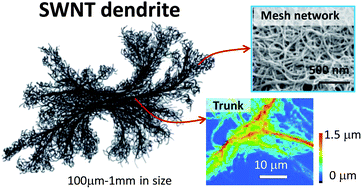Dendrimers (or apparently “arborols” for those who prefer nomenclature with a Latin flavour) offer some of the most fascinating molecular architectures in chemistry. Molecules such as PAMAM are robust, well defined spherical structures with several possible applications in the fields of sensors and drug delivery. They also provide the opportunity for chemists to produce some first-rate molecular models.
Fans of photogenic chemistry will now be pleased to hear that dendritic architectures have recently been observed in samples of another journal cover mainstay: the carbon nanotube.
The usefulness of composite materials prepared by introducing carbon nanotubes (CNTs) into a bulk polymer is well known; mechanical properties, conductivity and thermal properties can all be improved greatly. There is unfortunately a problem with getting the tubes sufficiently well dispersed throughout the polymer. Kobashi et al. have recently published work showing the formation and dispersion of a dendritic network of CNTs that is strikingly reminiscent of the structure of a tree or a circulatory system. The tubes form large, central “trunks” and then branch off again and again until, at the extremities of the network, only single tubes are visible.
The structures are not only aesthetically pleasing; they are also extremely useful. Use of the network allows a ten-fold increase in the conductivity of a rubber composite compared to individually dispersed tubes. When combined with epoxy resins the network was also able to improve the Young’s Modulus of the material (by 200% to 5.6 GPa) and the tensile strength (by 170% to 85 MPa). To prepare the networks the researchers use long (0.1 – 1 mm) tubes which are flexible and entangled. The nanotube forests (“carpets” of vertical tubes grown off a flat surface) are also imperfectly aligned which is believed to cause the required “meshes” instead of bundles. It is also envisaged that this novel method of CNT dispersion is scalable offering the potential for use in industry.
A dispersion strategy: dendritic carbon nanotube network dispersion for advanced composites
Chem. Sci., 2013, 4, 727. DOI: 10.1039/c2sc21266h
James Serginson is a guest web writer for the Journal of Materials Chemistry blog. He currently works at Imperial College London carrying out research into nanocomposites.
To keep up-to-date with all the latest research, sign-up to our RSS feed or Table of contents alert.











